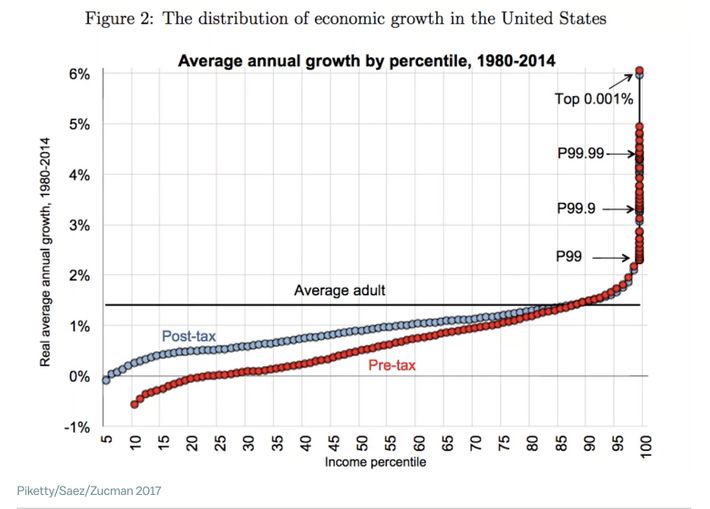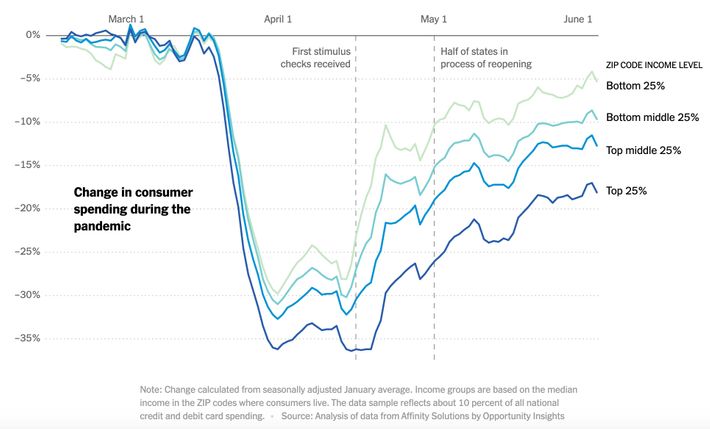This slipped beneath the radar last week.
"Shapiro, who is expected to be the new chief of the Office of Cuba Broadcasting, told colleagues in 2017 that his goal was to turn the entire USAGM -- then called the Broadcasting Board of Governors -- into a "Bannon legacy," CNN reported at the time."
LINK
Meanwhile..
"100°F about 70 miles north of the Arctic Circle today in Siberia. That's a first in all of recorded history," tweeted meteorologist Eric Holthaus. "We are in a climate emergency."
The reading comes as Siberia is in the midst of a prolonged heatwave that has.. been linked to wildfires, a huge oil spill, and a plague of tree-eating moths."
link.
LINK
The modern American economy is top-heavy by design.
In the late 1970s, many U.S. policymakers decided that income inequality had gotten too low. Strong union contracts had enabled many workers to earn more than their labor was worth, while excessive taxation of business was depressing productive investment. As a result, demand for goods had come to outstrip supply, leading to rising prices, which led to higher interest rates — which further discouraged supply-expanding investment — in a vicious, stagflationary cycle.
To the high priests of Reaganomics, the way out of this morass was clear: America needed to divert income away from those who spend it (i.e. workers) and toward those who invest it (i.e. the rich). After all, consumption gobbles up scarce resources, while investment reduces scarcity by enhancing the economy’s productive capacity. Breaking labor unions and slashing capital gains taxes would make the economy less equal. But such policies would also channel a higher share of national income toward growth-enhancing projects. And this would leave the typical worker with a somewhat smaller slice of a much larger economic pie. A rising tide would lift even the humblest of dinghies.
The basic premise of this growth model — that one can increase long-term, societal prosperity by suppressing consumption to fuel investment — may be valid in some contexts. For example, if you are a developing country that lacks basic infrastructure and manufacturing capacity, expanding the share of income available for investment will typically increase your overall wealth. China’s explosive growth during the 1990s and early aughts was built atop precisely this model. To make more capital available for rapid industrialization, authorities suppressed wages. This produced growth robust enough to lift workers’ living standards even as their share of income gains fell. Eventually, however, this strategy becomes self-defeating.
Channeling investment into genuinely productive projects gets harder once you’ve picked the low-hanging industrial fruit. And this challenge is all the greater in a context where the purchasing power of ordinary people has been systematically depressed: Simply put, when the vast majority of workers have little discretionary income, profitable business ideas are harder to find (businesses need paying customers, after all). Thus, at a certain point, wage suppression stops aiding growth and starts inhibiting it. In their (excellent) new book, Peking University economist Michael Pettis and Barron’s columnist Matthew Klein argue that China’s iteration of the investment-led development model has been obsolete for more than a decade. Unwilling or incapable of enacting reforms that would increase wages — and thus, consumption — Beijing has sustained employment and GDP growth by financing useless capital investments. Instead of giving ordinary Chinese people the financial means to assert their material wants and needs — and then enabling investment to flow into enterprises that fulfill those mass desires — China is building housing developments in cities without people.
In the U.S., the supply-side model has produced similar (if less egregious) imbalances. Before the coronavirus pandemic, record-high corporate profits coincided with aberrantly low business investment. As Republican Senator Marco Rubio lamented last year, America’s “nonfinancial corporate business sector routinely spends more on buying financial assets than on capital development.” Many factors have contributed to this outcome. But the fact that America’s ultrarich have commandeered the bulk of the past four decades of income growth is surely one.

The income distribution depicted above was a choice. With strong labor rights, high minimum wages, and more post-tax redistribution, the bottom 90 percent of U.S. households could have seen their incomes rise steadily over the past half-century. In that world, the typical American family would have less debt and more disposable income. And that mass purchasing power would allow the economy to support a wider array of businesses and services.
We opted for a different path. The U.S. slashed taxes on the wealthy, undermined unions, and let its social safety net remain exceptionally threadbare. As a result, America’s economic elites ended up with more income than they could spend or profitably invest in productive enterprises. So, they bid up the price of urban real estate, and bankrolled the development of socially useless financial innovation. Instead of directing the gains of growth toward better meeting the wants and needs of ordinary Americans, we built 1,000-foot towers full of perpetually empty luxury apartments that Russian criminals could use for money laundering.
This is a suboptimal way to run a country, in my opinion. But until recently, in cities where America’s affluent and Über-rich are heavily concentrated, the top-heavy economy was at least able to support a robust service sector. The rich may spend a much lower percentage of their income than the poor and middle class. But America’s rich still spend quite a lot. And if you pack enough rich people into a single stretch of land, they’ll generate a healthy amount of consumer demand in that area.
Alas, the COVID-19 crisis has revealed that organizing an urban economy around the conspicuous consumption of a highly mobile minority has significant downsides. During the present recession, job losses have been concentrated at the lower end of the labor market — and yet, wealthy Americans have cut their spending more sharply than working-class ones. New research from the economists Michael Stepner, Raj Chetty, Nathaniel Hendren, and John Friedman suggests that — thanks to government aid — low-income Americans’ personal spending is almost back to its prerecession level. But among high-earning households, consumption remains severely depressed.

Graphic: The New York Times
This is ostensibly because the consumption of the affluent is more heavily geared toward the purchase of discretionary, in-person services such as fine dining and live entertainment. Since rich people do not need these things — and a pandemic has drastically reduced their appeal — they’re liable to cut their spending, even if their jobs and incomes have been unaffected by the current downturn.
Which is disastrous for the service-sector economies that exist to satisfy their whims. As the New York Times reports:
Economists at the Harvard-based research group Opportunity Insights estimate that the highest-earning quarter of Americans has been responsible for about half of the decline in consumption during this recession. And that has wreaked havoc on the lower-wage service workers on the other end of many of their transactions, the researchers say…Unemployment claims have been high in rich counties that were largely immune to the last recession. And lower-income Americans living in those richer counties have been hit particularly hard. Their spending fell further than the spending of lower-income workers in poorer counties.… Patricia Namyalo, a server in a hotel restaurant on Capitol Hill in Washington, is gloomy about what’s ahead. She recalls when business began to dwindle in early March, before the city’s shutdown went into effect, and well before members of Congress, who sometimes dine at the hotel, recessed for the crisis…“The upper class was already aware that America was going to follow suit,” she said. “And people like myself — I didn’t quite get it at the time.”She suspects the same is true now. Higher-income consumers know they won’t be back to their old levels of dining out or spending any time soon, even with all the talk of cities reopening. Meanwhile, lower-wage workers wait, hoping for the call back to work.
The coronavirus pandemic would have devastated the U.S. economy no matter what growth model we’d pursued since 1980. No matter how you distribute income or organize industry, a deadly, highly transmissible virus is going to be bad for business.
But the gross inequities of the modern U.S. economy have deepened the COVID-19 recession. If more of America’s economic activity were geared toward meeting the needs of the median worker — and less toward serving the whims of the typical banker — then the pandemic-induced collapse in high-end consumption would have brought fewer jobs down with it. Meanwhile, if wages had kept pace with productivity gains over the past half-century, America would have entered this crisis with a larger economy and less financially vulnerable working class.
In ordinary times, our nation’s overreliance on the investment and consumption of the fickle rich depresses growth and corrodes democracy. In this extraordinary time, it is directly immiserating millions. We can and should build a better economy, one that keeps workers afloat in all seasons — no matter how choppy the waters or low the tide.







No comments:
Post a Comment
Note: Only a member of this blog may post a comment.